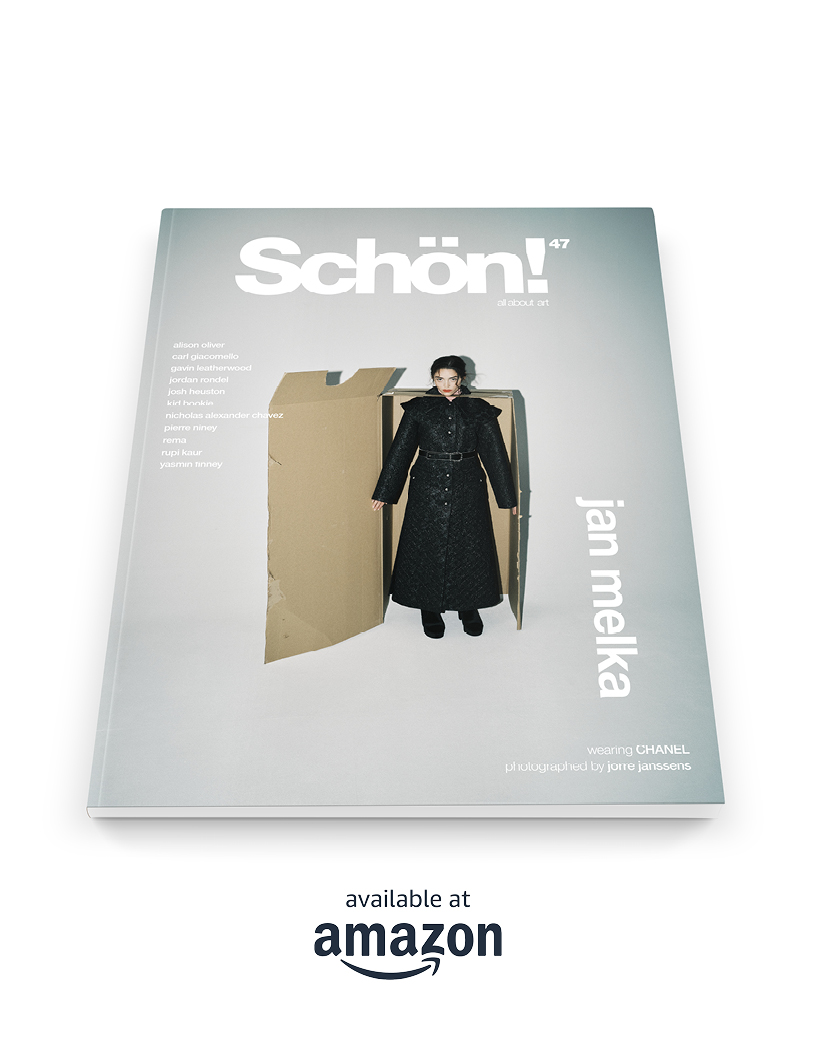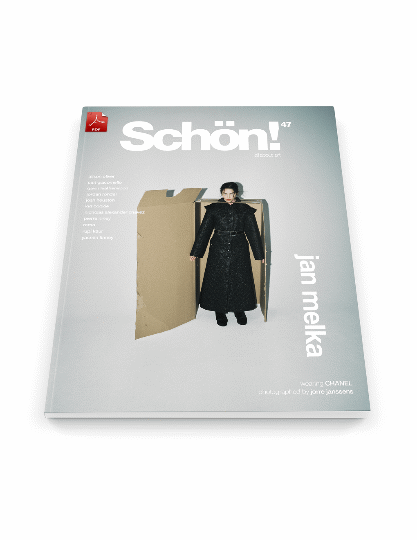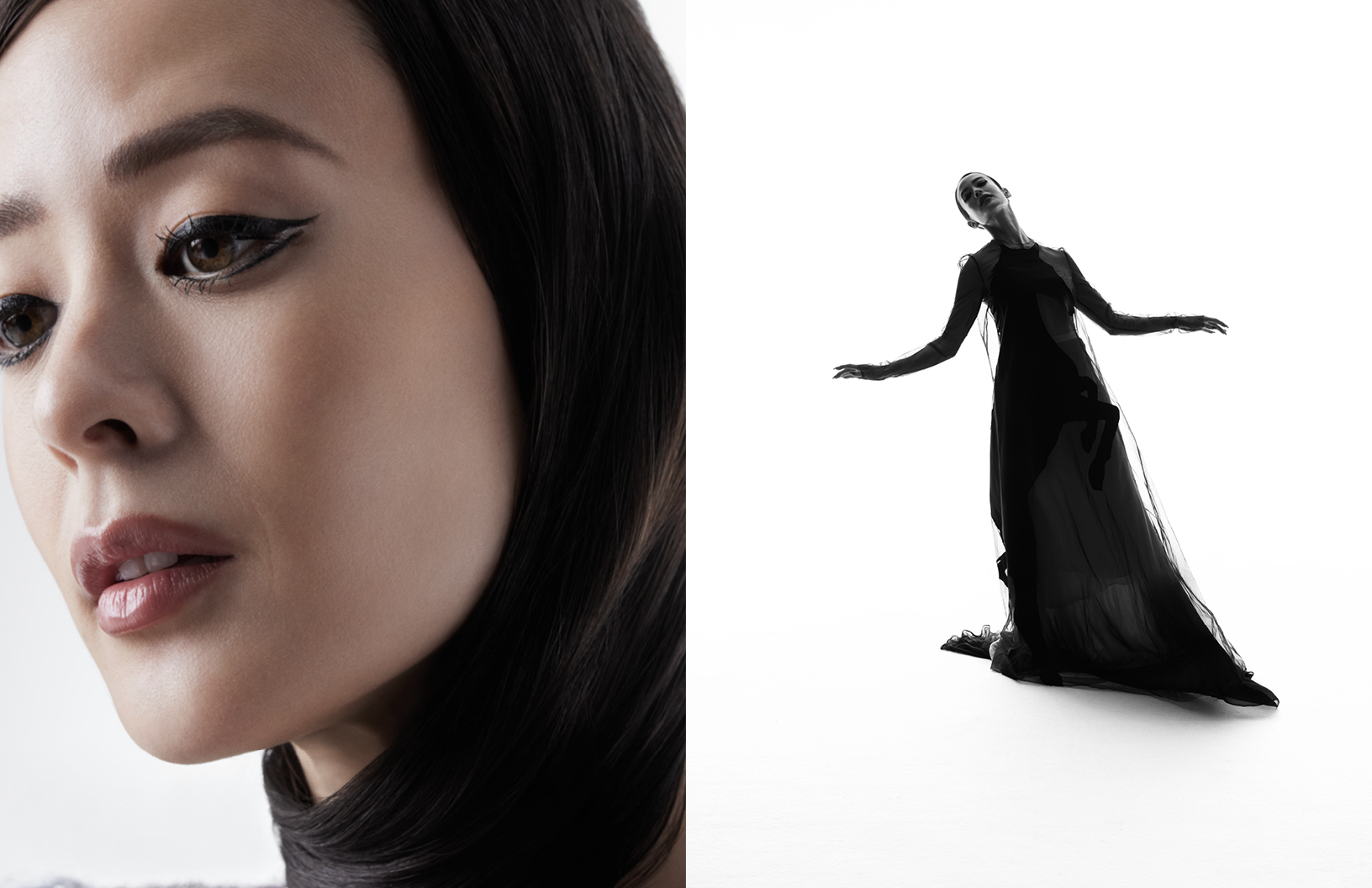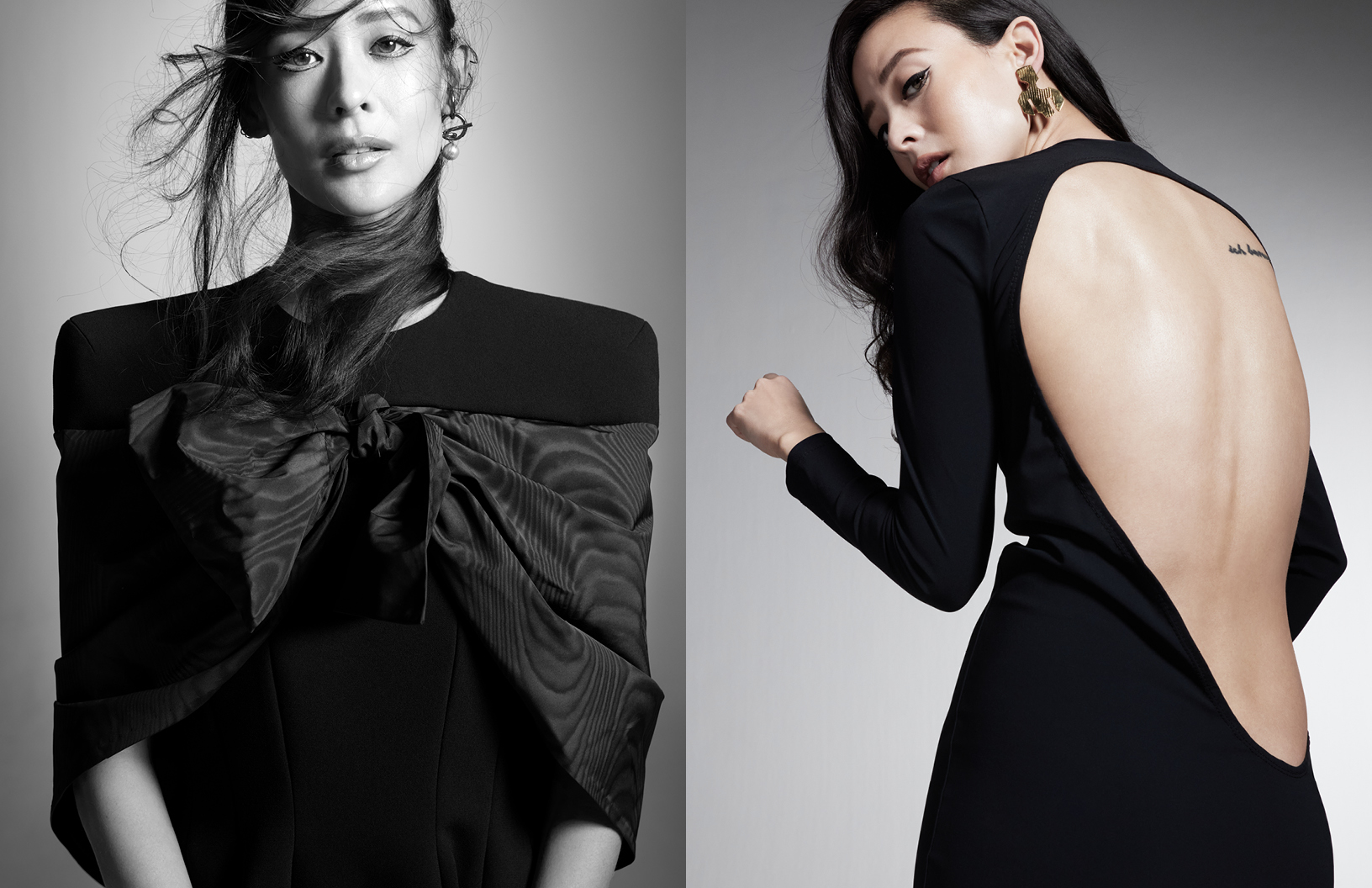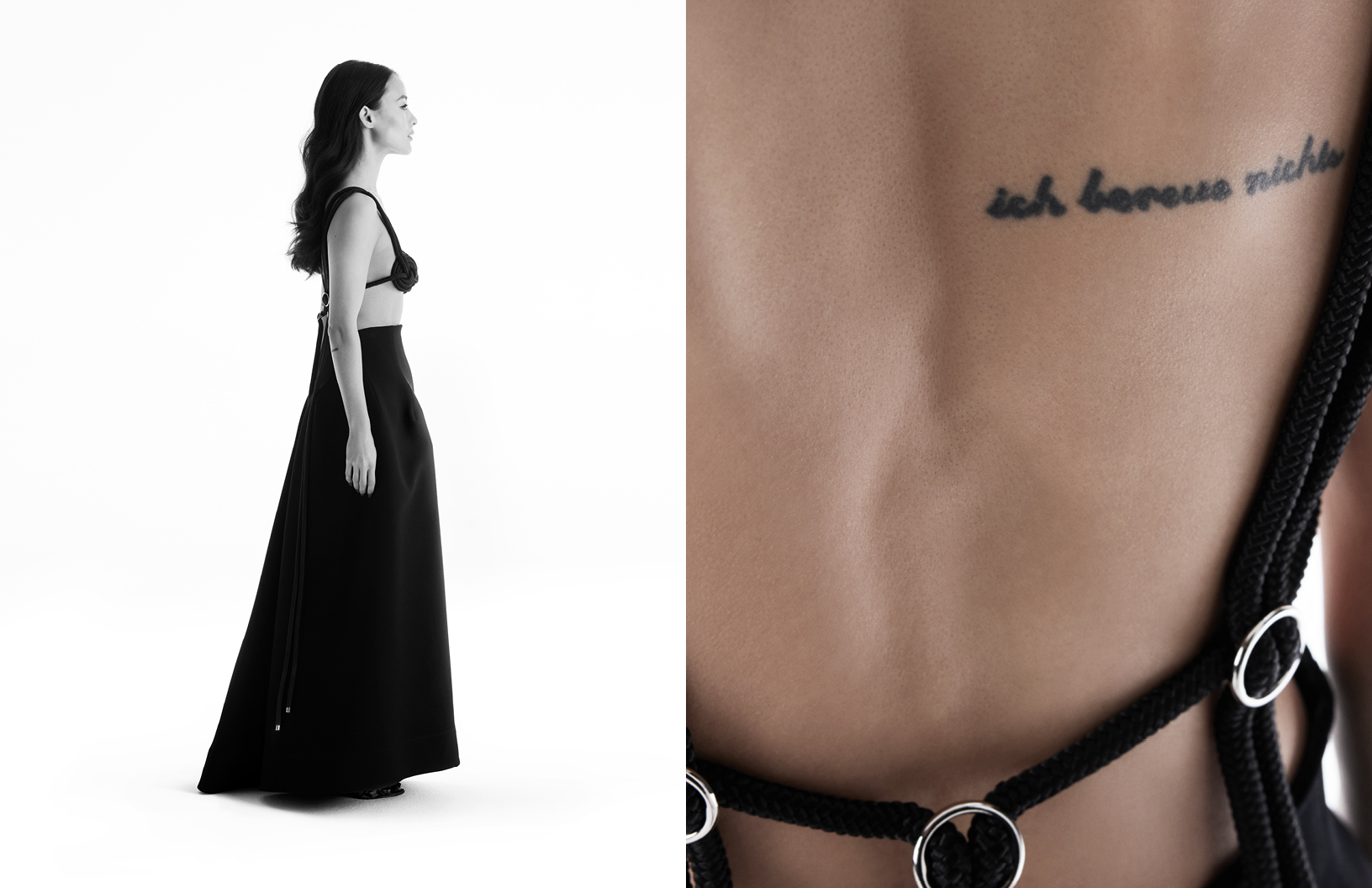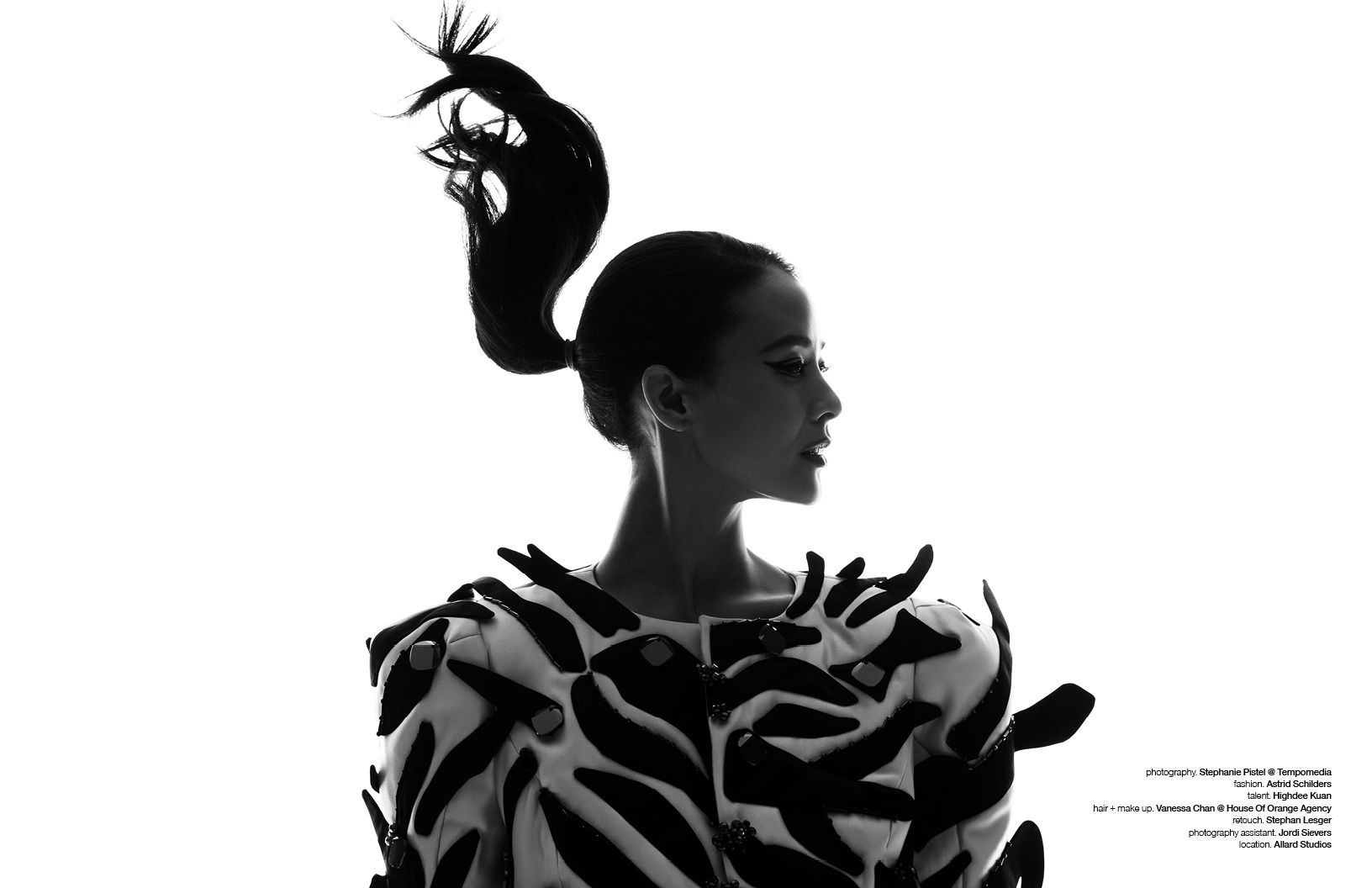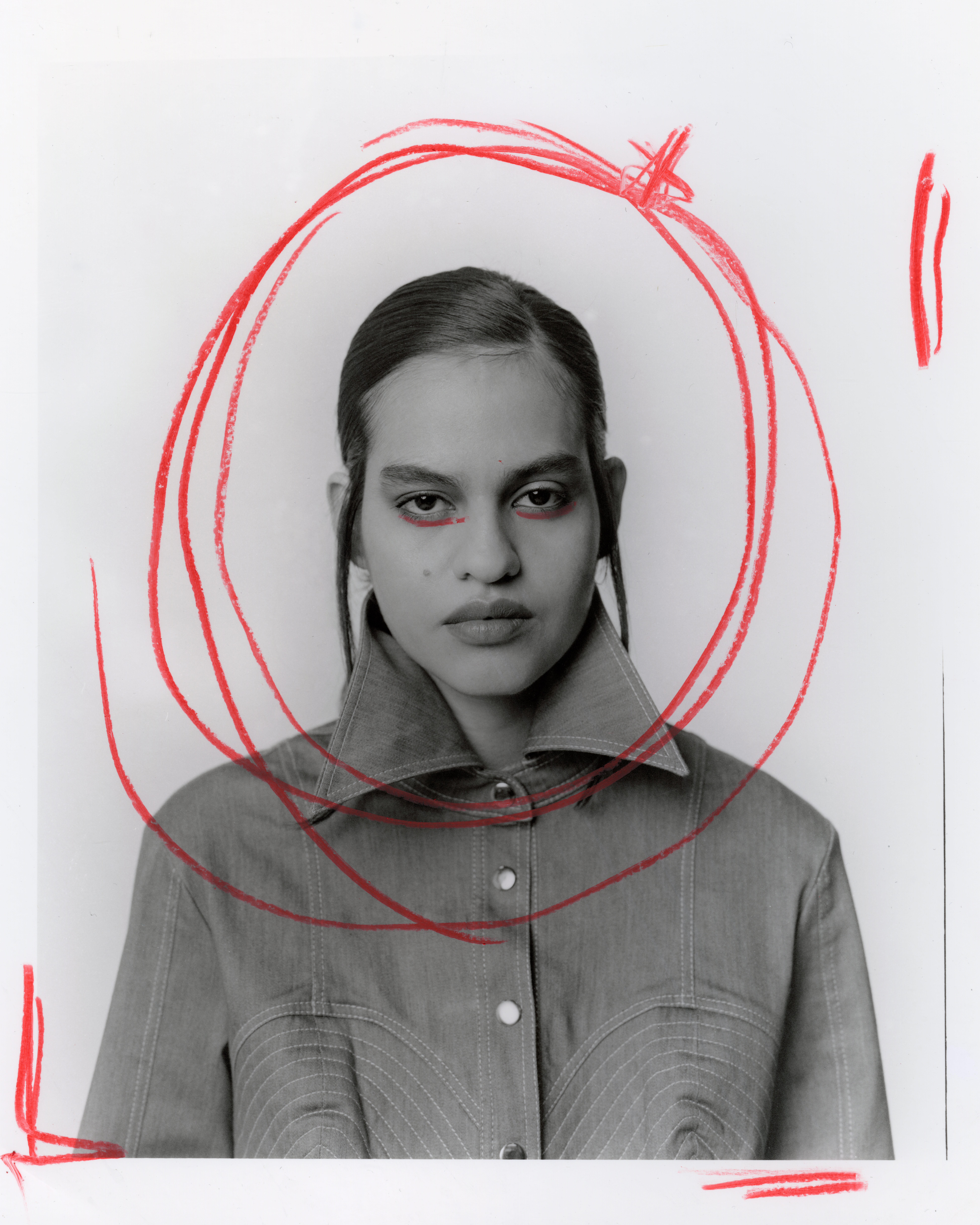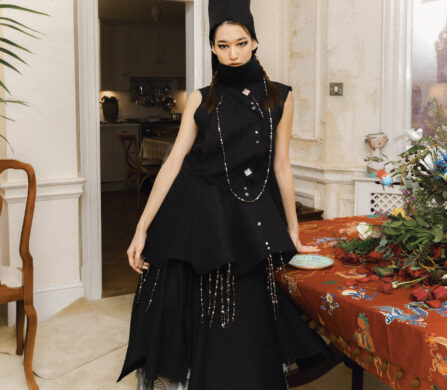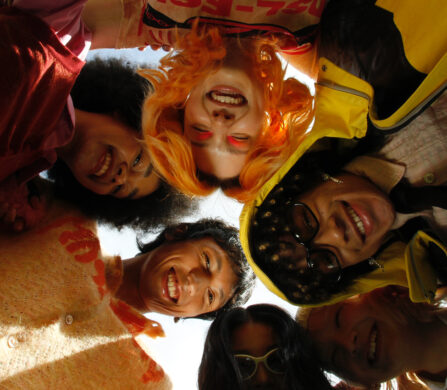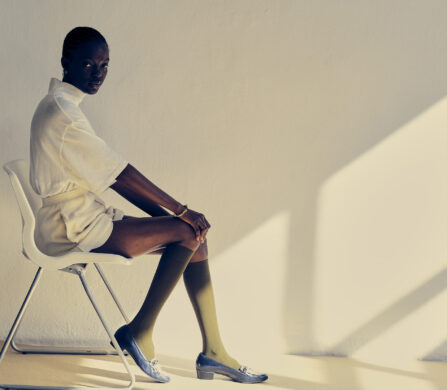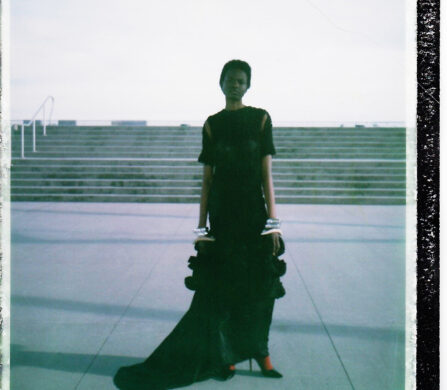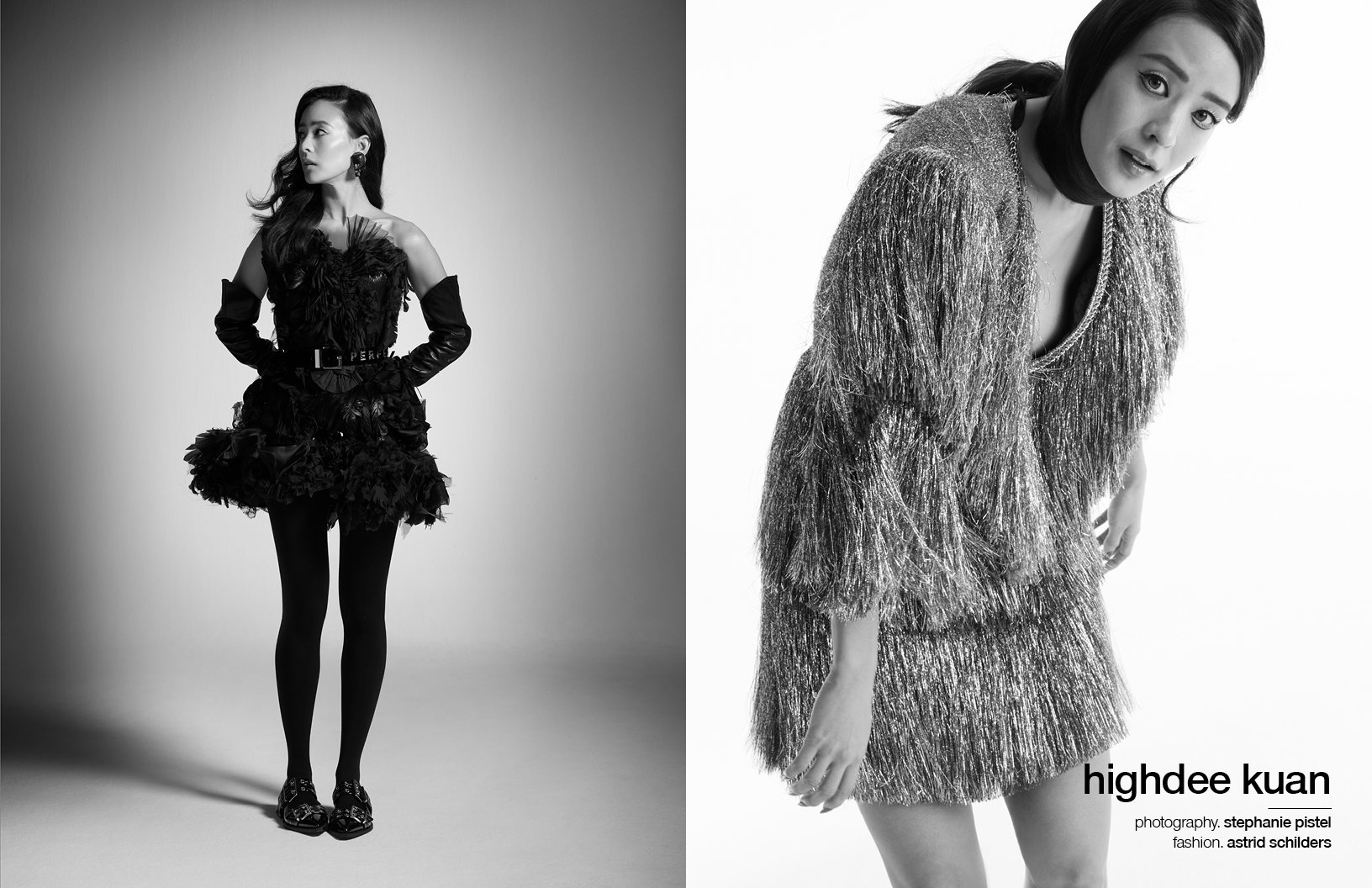
dress, earring + belt. Ronald van der Kemp
shoes. Ganni
gloves. Ines Gloves
tights. Falke
opposite
dress. Elisabetta Franchi
Step into Highdee Kuan’s world, where Hollywood glamour meets down-to-earth charm, and every role is a chance to shine. Beyond the glitz and glam, she stays true to herself, embracing her love for nature and charming everyone around her with a heart as big as her dreams. Growing up in a tiny Dutch village, Kuan always felt a bit different. But instead of fitting in, she danced to her own beat, finding solace in movies, books, and daydreams of far-off adventures. Fast forward to today, and you’ll find her trading in her ballet shoes for hiking boots, exploring California’s breathtaking landscapes and chasing sunsets like it’s her job.
But don’t let her laid-back vibe fool you. When it’s time to hit the screen, Kuan transforms into a powerhouse, breathing life into characters with a flair that’s all her own. From heart-pounding thrillers to emotion-filled dramas, she’s done it all — and she’s just getting started. In her latest gig, The Brothers Sun, the actress steps into the shoes of Alexis Kong, a fierce go-getter with a passion for justice and killer style to match. It’s a role that’s got her channelling her inner boss babe, taking names and kicking butt in the name of truth and righteousness.
Schön! sits down with the actress to chat about her ever-changing fashion sense, breaking down her relatable character in The Brothers Sun, her dream projects and roles, and much more.
Highdee, when you’re not dazzling us on-screen, what are some hobbies or interests that bring you joy and relaxation? Any quirky or unexpected passions that fans might not know about yet?
I really enjoy getting outdoors as much as possible, especially here in California where we’re spoiled with amazing hiking trails and beautiful national parks. Other than that, I enjoy spending time with my family, thrifting, tinkering on little projects around the house, that sort of thing. Lately, I’ve been going to the driving range to practice my golf swing, but to be honest, it brings me more frustration than relaxation.
You’ve had quite the journey into the world of acting. What ignited your passion for storytelling, and how did you find your way into the entertainment industry?
As a kid, growing up in this tiny Dutch village, I always felt different from everyone around me, like a bit of an outsider. So I’d rush home after school and immerse myself in my favourite movies or books, fascinated with the ‘behind the scenes’, or ‘making of’ content – that was my little sanctuary. My journey began as a dancer, and through that medium, I discovered my passion for storytelling, character creation, and just art in general. It was a means of escaping into a world that I could shape and define.
Your background in classical ballet is fascinating. How has your dance training influenced your acting style?
It has really given me a solid foundation of discipline. One of my favourite mantras is “discipline over motivation,” and I carry that with me in every role that I tackle because it helps me stay prepared and present. Once I feel prepared in terms of understanding the story, the character arc, and the scene, then I can let go and be totally available for my scene partner and my character.
I read online that you have a passion for fashion and design. Who’s your favourite designer?
Oh, that’s a tough one. I’ve had a love for fashion since a young age because the easiest way that I could channel a certain character was through what I wore. I don’t have a favourite – I know it sounds cliché – but there are things I admire in every fashion show I see. However, I must say I’ve always had a lot of admiration for Iris van Herpen. Her pieces are just otherworldly.
Your portfolio boasts a mix of genres, from psychological thrillers to family dramas. Is there a particular genre you enjoy sinking your teeth into, or do you love the diversity that comes with each role?
I really love exploring stories and genres that leave you profoundly moved at the end of it, because personally, I’d rather be moved by what I am watching than just entertained. So if I read a script and my initial instinct is to run from it or tell myself, ‘I can’t do this,’ then I know I’m onto something. That excites me because I love a challenge. Playing characters that feel foreign, scary, and different from who I am, is the ultimate thrill as an actor.
Having been in series like You, This Is Us, and Fear of the Night, what has been your favourite role or project so far, and why?
That’s a tough question because each project holds a really special place in my heart. And I feel like a different person for each of those projects, so I really can’t pick a favourite. Ask me in 10 years, haha!
You’re fluent in English, Mandarin, and Dutch – that’s quite a linguistic feat! How does your multicultural background shape the roles you take on, and do you have a preferred language to perform in?
I always find it interesting to consider language, accents, and cadence as an extension of the character and their background. Recently I did an audition with a German accent, just to see where it would take the character, and I realized that I discovered little moments that I couldn’t access in American English, which was fascinating. I prefer acting in English though, because that is what I am most fluent in nowadays.
Being part of a series like The Brothers Sun must have been exhilarating. What was it like working alongside the legendary Michelle Yeoh and how did the cast manage to bring this unique story to life?
We really became a family on this one, with the incredible Michelle being our fantastic matriarch on and off-screen. She’s genuinely one of the kindest and most talented people I’ve ever met and probably will meet. But honestly, everyone on our set was so incredibly kind, and we all had a blast, which really should be credited to Brad, Byron, Kevin, and Viet. They really set the tone on this one.
In the series, you play Alexis Kong, an ambitious assistant district attorney who’s determined to close the case on the Triad criminal gang at all costs. Can you delve into more details about her character’s past and how it influences her present actions in the series?
Alexis was, in many ways, an enigma to me at first. Yet she also felt intimately familiar at the same time, like I was exploring different facets of myself as the season progressed. I believe she has always been someone who values structure, order, and justice, even from a young age. Her moral compass has consistently guided her, and she possesses a fearlessness in the sense that she doesn’t feel the need to apologize for who she is. And that’s liberating.
The creators of the show, Brad Falchuk and Byron Wu, have crafted a complex character in Alexis Kong. How did you collaborate with them to ensure Alexis was portrayed in a way that stayed true to the vision of the series?
Brad and Byron are true collaborators in every sense of the word. Before production, we had some really insightful conversations about who Alexis is and what makes her tick, but they were also genuinely interested in who I am as a person and how one informs the other. Their notes always felt like they served the character and the story in the best way possible, and I couldn’t have asked for better showrunners. I tend to feel really protective over the characters I play, but with them at the helm, I always felt safe and in good hands.
Apart from loving spicy ramen noodles, Alexis is also a fashion enthusiast. As a fashion lover yourself, did you have any input into shaping her style, and how did the character’s fashion choices contribute to her personality?
I think Alexis is very self-aware. She recognizes the fact that she stands out in certain professional spaces—she’s young, a person of colour, and a woman. She’s opinionated and outspoken, and because of that awareness, she knows how to shape the narrative surrounding her. It’s like, ‘If you’re going to look at me, I want you to see me like this.’ While she may not necessarily have the time or budget for lavish shopping, she likes to present herself in a way that empowers her, and I know they didn’t want to dress her too ‘’corporate’ or ‘attorney-esque’. Personally, I’d love to see her in a Saint Laurent suit set. Or in a Tom Ford menswear look. Some day.
Within the first episodes, we get to know about her relationship with Charles Sun. Without giving away any spoilers, can you tease a bit about the journey we can expect for Alexis Kong throughout the series? And how’s that going to affect their relationship?
I like to consider Alexis’ arc in the context of being motivated by fear or love. Like, what drives her actions? Is it fear, or is it love? She learns very early on in life that the world doesn’t think or operate in the way that she does, and that is isolating for her. I think she’s so busy that she might not fully grasp how isolated she truly is. However, when Charles reappears in her life, there’s a part of her that realizes that she craves a connection and that through their shared history and traits, they can find comfort and solace in each other.
I think their bond is strong enough to endure a lot, but whether or not they’re willing to compromise on their core beliefs will determine their outcome.
Every character in the series has those standout moments, whether good or bad. Do you have a favourite scene or moment involving Alexis that you can’t wait for viewers to see?
The interrogation scene felt like a very cathartic moment for Alexis. She finally gets to look Charles in the eye and lay out her side of the story. There is a moral ambiguity to their journey that feels really delicate, but placing them face to face in such a raw state, was powerful.
The chemistry between characters is crucial. How did you work with the cast to build that on-screen camaraderie, especially considering the dynamics between Alexis and other characters in the series?
I feel incredibly fortunate to have some of the best castmates on this show. With Justin, who plays Charles, there was always complete trust that he would show up and give his all not only to his character but also to Alexis. We discussed our shared memories of our characters early on, recalling what we did as kids and where in Taiwan we first met. It created a perfect foundation of trust and knowledge that we both could build upon.
My other co-star, Rodney To, who plays Detective Mark, is genuinely one of my favourite humans ever, and we became thick as thieves during the show. He truly is my partner in crime on-screen and off-screen. There’s a moment in Episode 8 where we hug each other, and it was one of those moments where there was no acting involved. That was just Highdee and Rodney, two friends hugging each other. It’s really pure and cute. I love that moment.
Looking ahead, are there any dream roles or types of projects that you’re itching to take on? Any genres or characters you’re dying to explore?
Generally, as a viewer, I am a sucker for independent films, especially the really heavy and dramatic ones. So I’d love to work on that. But I’d also love to play a really messy character, you know, someone who is genuinely unpredictable and volatile, navigating through the chaos of life. I think that could be really exhilarating. Or take on a more comedic character. Actually– I’d love to do it all.
The Brothers Sun is streaming now on Netflix.
photography. Stephanie Pistel @ Tempomedia
fashion. Astrid Schilders
talent. Highdee Kuan
hair + make up. Vanessa Chan @ House Of Orange Agency
retouch. Stephan Lesger
photography assistant. Jordi Sievers
location. Allard Studios
interview. Gennaro Costanzo
